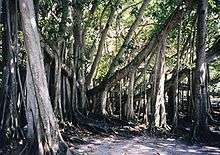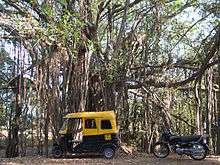Ficus benghalensis
| Ficus benghalensis | |
|---|---|
 | |
| An Indian banyan tree (Ficus benghalensis) in front of the Edison museum in Fort Myers, Florida | |
| Scientific classification | |
| Kingdom: | Plantae |
| (unranked): | Angiosperms |
| (unranked): | Eudicots |
| (unranked): | Rosids |
| Order: | Rosales |
| Family: | Moraceae |
| Genus: | Ficus |
| Subgenus: | Urostigma |
| Species: | F. benghalensis |
| Binomial name | |
| Ficus benghalensis L. 1753 | |
| Synonyms[1] | |
| |
Ficus benghalensis, with the common name Indian banyan,[2] is a tree which is native to the Indian Subcontinent. Specimens in India are among the largest trees in the world by canopy coverage.
Ecology
Ficus benghalensis produces propagating roots which grow downwards as aerial roots. Once these roots reach the ground they grow into woody trunks.
The figs produced by the tree are eaten by birds such as the Indian myna. Fig seeds that pass through the digestive system of birds are more likely to germinate and sprout earlier.[3]
Cultural significance
Ficus benghalensis is the national tree of the Republic of India.[4]
The tree is considered sacred in India,[5] and temples are often built beneath. Due to the large size of the tree's canopy it provides useful shade in hot climates.
In Theravada Buddhism, this tree is said to have been used as the tree for achieved enlightenment, or Bodhi by the twenty seventh Lord Buddha called "Kassapa - කස්සප". The sacred plant is known as "Nuga - නුග" or "Maha nuga - මහ නුග" in Sri Lanka.[6]
Notable specimens
The giant banyan trees of India are the largest trees in the world by canopy coverage. One individual specimen, Thimmamma Marrimanu, in Andhra Pradesh, covers 19,107 m2 (4.721 acres) and is the largest single tree by two-dimensional canopy coverage area.[7] This tree is also the world's largest known tree by perimeter length with a perimeter of 846 m (2,776 ft).
Nearchus, an admiral of Alexander the Great, described a large specimen on the banks of the Narmada River. The tree's canopy was so extensive it sheltered 7000 men. It was later described by James Forbes (1749–1819) in his Oriental Memoirs (1813–1815) as nearly 610 m (2,000 ft) in circumference with over 3000 trunks.[8]
Other notable specimens include The Great Banyan in the Indian Botanic Garden and Dodda Alada Mara in Karnataka.

See also
References
- ↑ The Plant List, Ficus benghalensis Linnaeus
- ↑ "Ficus benghalensis L.". Germplasm Resources Information Network (GRIN). Retrieved 8 May 2016.
- ↑ Midya, S.; Brahmachary, R. L. (1991) "The Effect of Birds Upon Germination of Banyan (Ficus bengalensis) Seeds". Journal of Tropical Ecology. 7(4):537-538.
- ↑ "National Tree". Govt. of India Official website.
- ↑ Simoons, F.J. (1998). Plants of Life, Plants of Death. University of Wisconsin Press. ISBN 9780299159047.
- ↑ http://www.instituteofayurveda.org/plants/plants_detail.php?i=858&s=Family_name
- ↑ Bar-Ness, YD (March 2013). "Giant Banyans - The World's Largest Trees?". GEO (89).
- ↑
 Chisholm, Hugh, ed. (1911). "Fig". Encyclopædia Britannica (11th ed.). Cambridge University Press.
Chisholm, Hugh, ed. (1911). "Fig". Encyclopædia Britannica (11th ed.). Cambridge University Press.
Further reading
Dhanya, B. (Jun 2013). "Does litterfall from native trees support rainfed agriculture? Analysis of Ficus trees in agroforestry systems of southern dry agroclimatic zone of Karnataka, southern India". Journal of Forestry Research. 24 (2): 333–338. doi:10.1007/s11676-013-0357-6.
External links
| Wikimedia Commons has media related to Ficus benghalensis. |
| Wikispecies has information related to: Ficus benghalensis |
- Bar or Bargad Ficus benghalensis L., Horticulture, Purdue University
- Ficus benghalensis in Himalayas, Nepal. Himalayas (Himalaya): photos, images, pictures
- Farhang-e-Asafiya (فرہنگ آصفیہ), Urdu Science Taraqqi Board, Lahore-1983
- Urdu Lughat (اردولغت), Urdu Dictionary Board, Karachi 2010